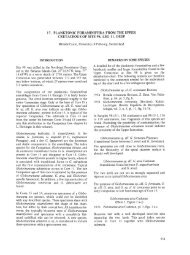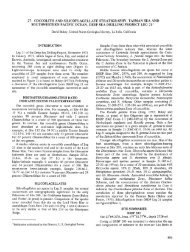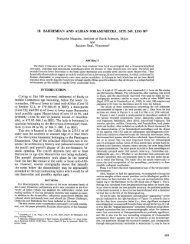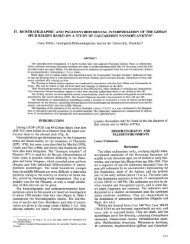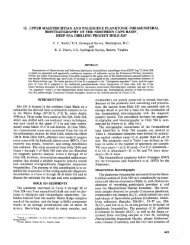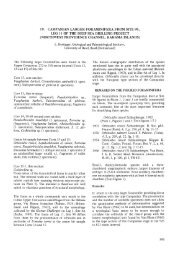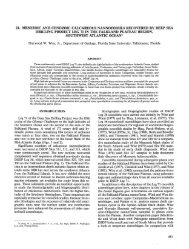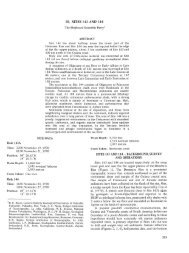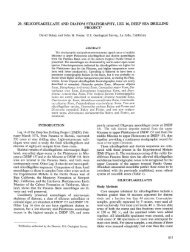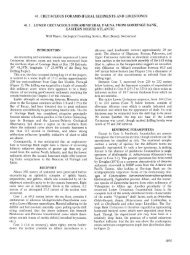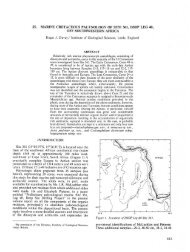16. Radiolaria - Deep Sea Drilling Project
16. Radiolaria - Deep Sea Drilling Project
16. Radiolaria - Deep Sea Drilling Project
Create successful ePaper yourself
Turn your PDF publications into a flip-book with our unique Google optimized e-Paper software.
M. G. PETRUSHEVSKAYA, G. E. KOZLOVA<br />
Holocryptocanium barbui Dumitrica, Holocryptocapsa sp.<br />
aff. hindei (Tan Sin Hok), Squinabollum sp. aff., S. fossilis<br />
(Squinabol), *Dictyomitra pseudomacrocephala Squinabol,<br />
*D. costata (Squinabol), *D. veneta (Squinabol), D. tiara<br />
(Holmes), *D. multicostata Zittel group, D. crassispina<br />
(Squinabol), *Stichocapsa sp. aff. *S. ferosia (Kh. Aliev), S.<br />
disparlita (Kh. Aliev), S. sp. aff., *Lithostrobus elegans<br />
Squinabol, *Eusyringium sp. aff. *Theocampe subtilis<br />
Squinabol, *Conosphaera sphaeroconus Rust, Conosphaeral<br />
fossilis Squinabol, IHexapyramis sp., Pseudoaulophacus<br />
super bus (Squinabol), *Pseudoaulophacidae<br />
gen. et sp. indet. (The most numerous specimens are<br />
marked with an asterisk.)<br />
Its great similarity to the Cenomanian complex of the<br />
northeastern Caucasus speaks for the Cenomanian age of<br />
this complex (besides the data on the foraminifera and<br />
nannoplankton analysis): many of the above-mentioned<br />
species were found by Aliev (Kh. Aliev, 1965; at this point a<br />
group of them was assigned new synonymous names);<br />
Holocryptocanium barbui and Holocryptocapsa cf. hindei<br />
(Dumitrica, 1970) were described from the Cenomanian<br />
deposits of the Carpathian Mountains. However, it should<br />
be noted that almost all the species in the above list (with<br />
the exception of Cryptamphorella sp., Holocryptocapsa<br />
hindei and Holocryptocanium barbui) have a broader<br />
vertical distribution in the Atlantic region as well as on the<br />
European mainland; they were found in Caucasian Albian<br />
rocks (Kh. Aliev, 1965), in the Upper Cretaceous rocks of<br />
Italy (Squinabol 1903, 1904, 1914), in the Upper<br />
Cretaceous (Lower Turonian) rocks of the Rumanian<br />
Platform (P. Dumitrica collection); some species were<br />
encountered by Pessagno in the Lower Albian of the<br />
Atlantic (Pessagno 1970, Leg 1, Hole 5A, Core 3).<br />
Apparently the above-mentioned species in general are<br />
characteristic for both the Lower Cretaceous and lower<br />
horizons of the Upper Cretaceous of the Alpine Zone and<br />
the Atlantic region.<br />
<strong>Radiolaria</strong>n skeletons from the Cenomanian rocks are<br />
almost without exception poorly preserved; they usually<br />
occur as light transparent nuclei. In order to reveal the<br />
still-preserved sculpture we had to remove the skeletons<br />
from the balsam medium, into the vinegar-formaldehyde<br />
medium commonly used by diatomists.<br />
The Early Campanian Complex<br />
Deposits of this age were also discovered near the<br />
African coast from Site 137, Cores 6 and 5 (209 to 225<br />
meters below sea floor level) and from Site 138, Core 5<br />
(332 to 341 meters). The containing rocks are brown<br />
zeolitic clays. The most complete composition of the<br />
complex is: Dictyomitra duodecimcostata Squinabol, D.<br />
regina (Campbell and Clark), D. sp. aff. Stichocapsa tecta<br />
Rust, D. multicostata Zittel group, Cryptamphorella sp.<br />
aff., C. conara (Foreman), Cryptamphorella sphaerica<br />
(White), Myllocercion sp. aff., M. minima Dumitrica,<br />
*Pseudoaulophacus superbus (Squinabol), P. sp. aff. P.<br />
parqueroensis Pessagno, *Patellula planoconvexa<br />
(Pessagno), *P. verteroensis (Pessagno), P. sp., Dactyliosphaera<br />
sp. aff., Lithocyclia justa Rust, Histiastruml<br />
valanginica Kh. Aliev, IHexapyramis sp., *Porodiscus<br />
cretaceus Campbell and Clark, *Lithelidae gen. B,<br />
Lithelidae gen. A.<br />
496<br />
The specific character of this complex is determined by<br />
the predominance of large Discoidea, the majority of which<br />
have a pseudoaulophacid structure. A very similar fauna,<br />
almost identical in its species composition, was found by<br />
Pessagno (1963) in the Cariblanco Formation and in the<br />
limestones of the Parguera, Puerto Rico (Lower Campanian).<br />
On the basis of this similarity it is possible to<br />
stipulate the Early Campanian age of the complex with<br />
pseudoaulophacidae.<br />
Maestrichtian Complex<br />
Found in the equatorial part of the western and eastern<br />
Atlantic, Site 137, Core 4 (165 to 173 meters below sea<br />
floor level), Site 140, Core 8 (645 to 651 meters), Hole<br />
144, Core 3 (162 to 166 meters) and Hole 144A, Core 4<br />
(171 to 180 meters). The containing rocks are nannofossilforaminiferal<br />
marls, and oozy zeolitic clays with interlayers<br />
of quartzy sandstones.<br />
Incomplete list of the species: Dictyomitra multicostata<br />
Zittel group, D. ornata Kh. Aliev, D. sp. aff., D. regina<br />
(Campbell and Clark),D. tiara (Holmes),A striata Lipman,<br />
Amphipyndax enessefi Foreman, A. stocki (Campbell and<br />
Clark), A. plousious Foreman, Stichocapsa asymbatos<br />
(Foreman), S. cingulata (Squinabol), S. sp. aff. producta<br />
(Kh. aliev), Gongylothorax sp. aff., G. verbeeki (Tan Sin<br />
Hok), Theocapsomma sp. aff. T. comys Foreman,<br />
Theocampe! bassillis Foreman, Theocampe ? daseia Foreman,<br />
Rhopalosyringium sp. aff. R. magnificum Campbell<br />
and Clark, R. colpodes Foreman, Theocampe sp. P.<br />
myllocercion sp. C. Diacanthocapsa ovoidea Dumitrica,<br />
Bathropyramis sanjoaquinensis Campbell and Clark,Petassiforma<br />
speciosa (Squinabol), Tripodisciumi sp. aff. Lithomelissa<br />
hoplites Foreman, Porodiscus cretaceus Campbell<br />
and Clark, P. delicatulus (Lipman), Spongotrochus polygonatus<br />
(Campbell and Clark), Spongotripus morenoensis<br />
Campbell and Clark, Pseudoaulophacus gallowayi (White),<br />
P. superbus (Squinabol), Cenosphaera sp. aff. C. euganea<br />
Squinabol, Spongosaturnalis (M) sp. aff. S. latuformis<br />
Campbell and Clark, Cenosphaera sphaeroconus Rust,<br />
Stylatractus (?) sp., Spongoprunum (?) sp. aff. Cyphantus<br />
probus Rust, Lithelidae gen. A and others.<br />
The majority of these species, according to the data of<br />
Foreman (1968, Table 1) are distributed from the Late<br />
Campanian to the Late Maestrichtian. However, on the<br />
whole, the given association, in its species composition,<br />
appears to be closest to the Late Maestrichtian complex of<br />
California described and depicted in the above-mentioned<br />
work. Only in the Maestrichtian were found small Tricyrtida:<br />
Rhopalosyringium colpodes, Theocampe bassilis,<br />
Theocapsomma comys. Complexes from Sample 24A-11<br />
(Atlantic, Leg 4; Riedel and Sanfilippo, 1970) and Sample<br />
59-2-5-CC (Pacific, Leg 6; Kling, 1970) seem somewhat<br />
older due to the absence of this particular group of species;<br />
species of the genus Amphibrachium also tend to give it an<br />
ancient aspect.<br />
Site 136 (34° 10.13'N, 16° 18.19'W; water depth 4169<br />
meters)<br />
At a depth of 269? to 271 meters below the sea floor, in<br />
Sample 6-1, and also in Samples 6-CC, very poorly<br />
preserved radiolarians were found, mainly nuclei. The



